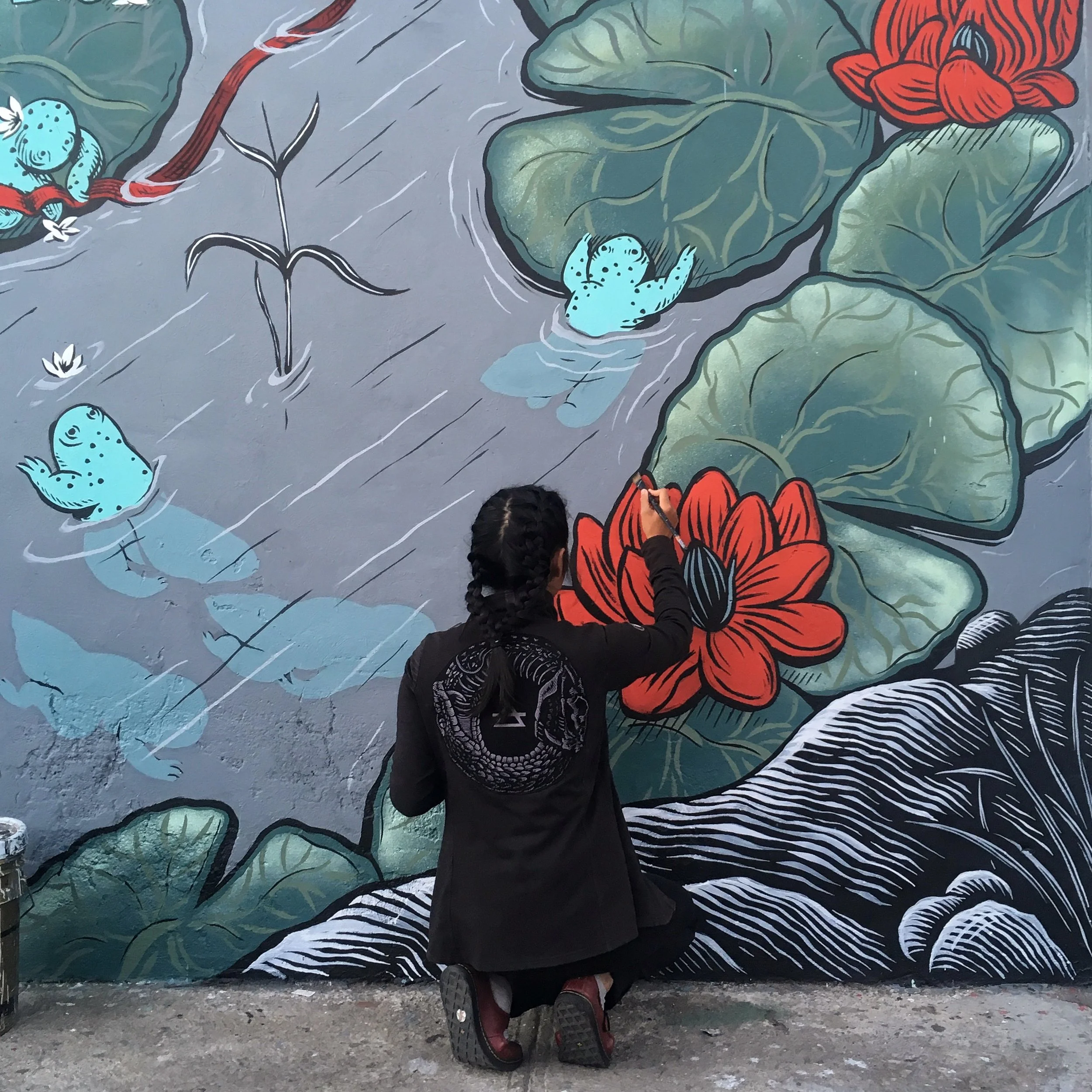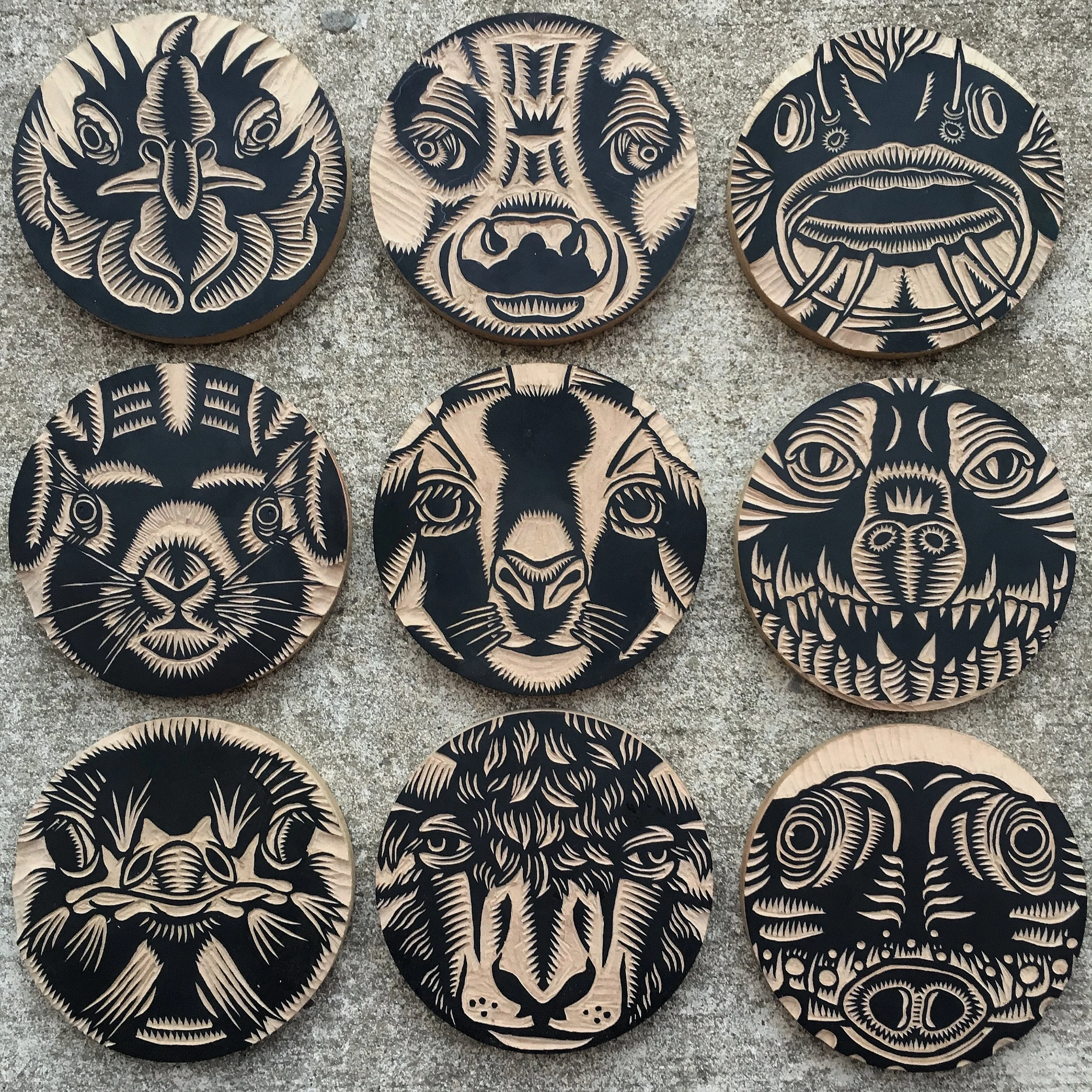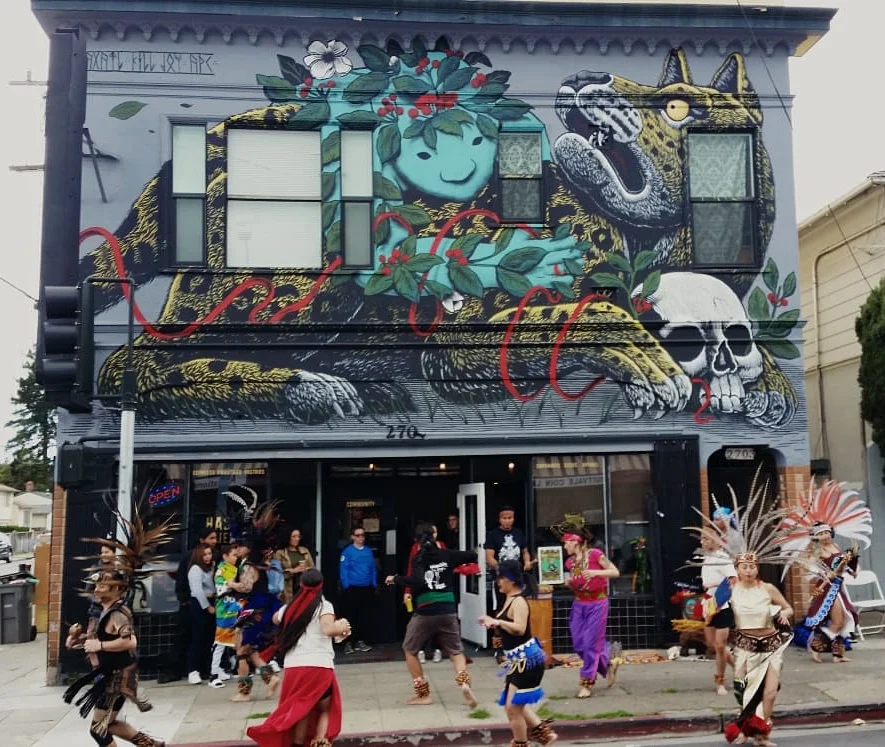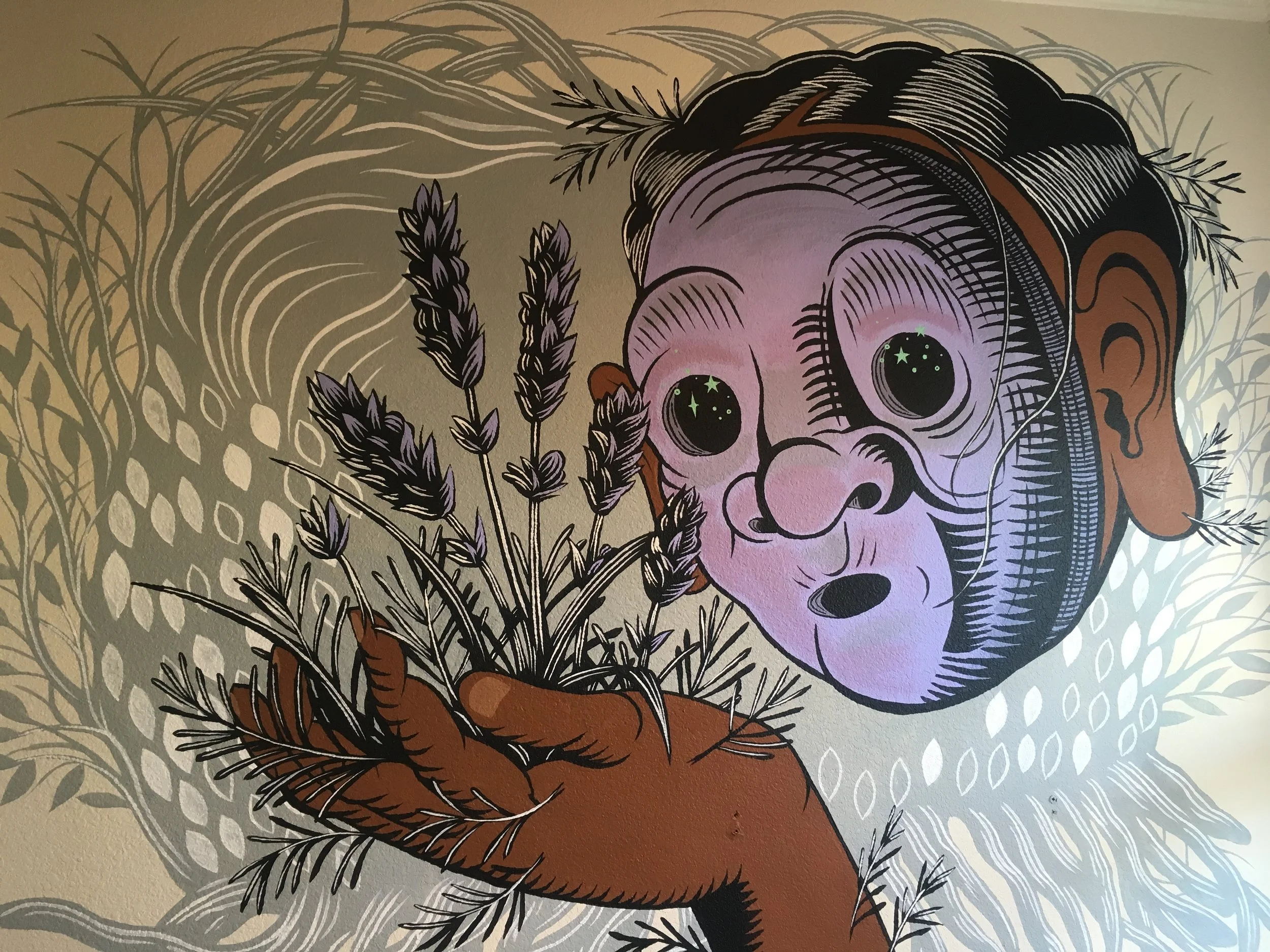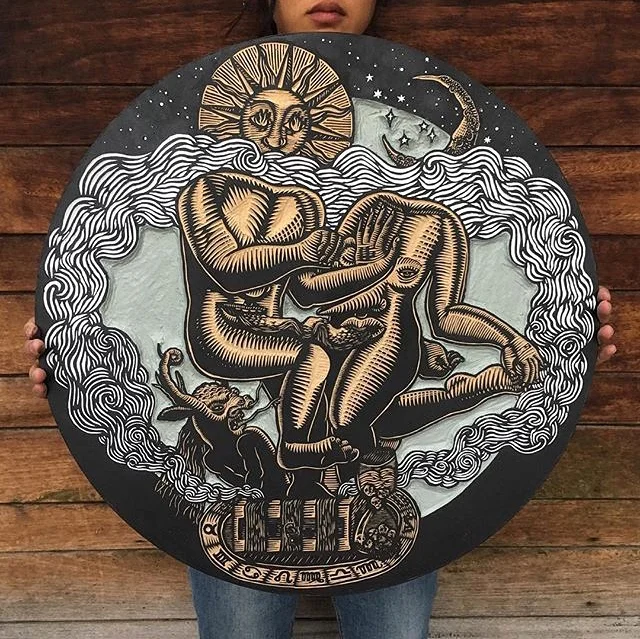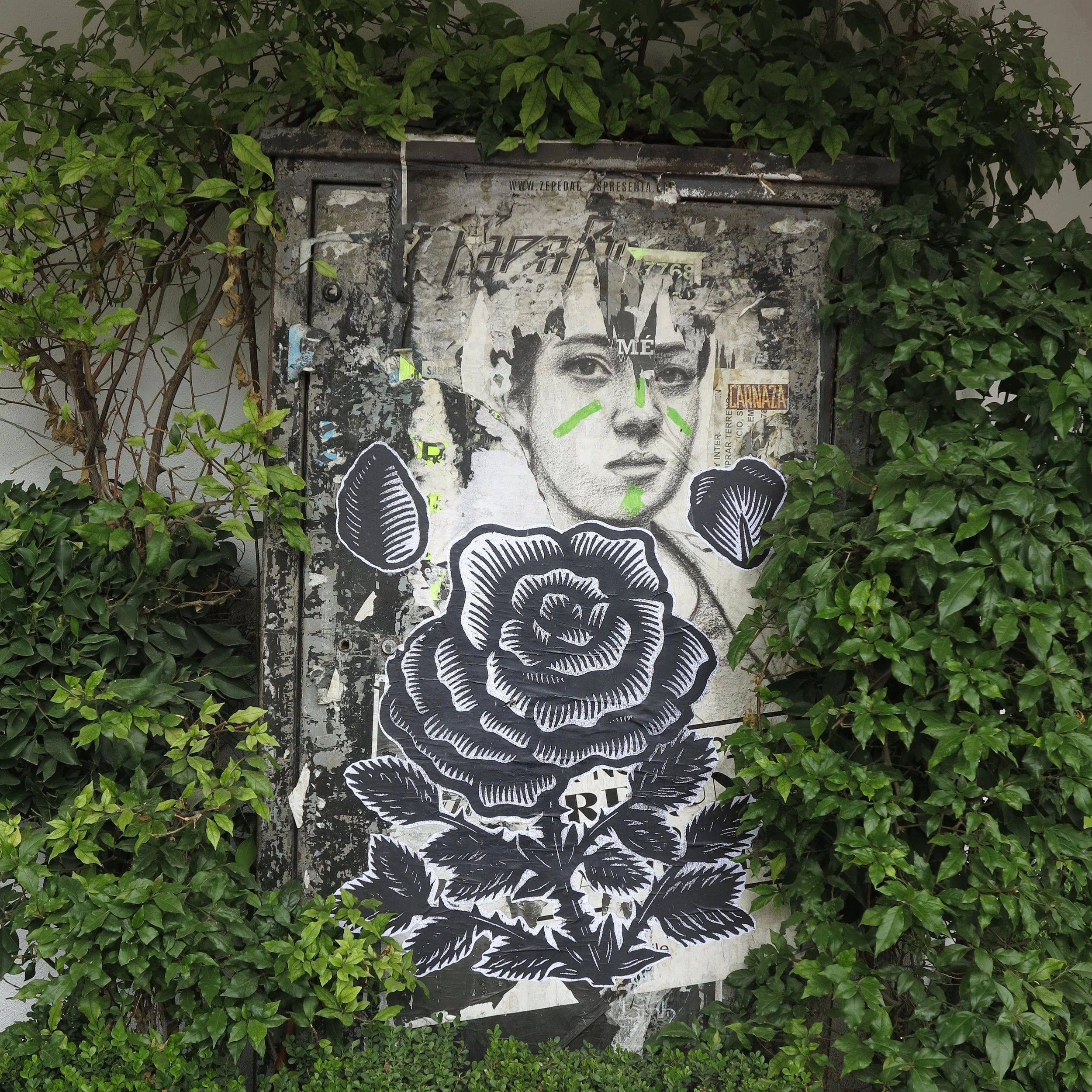An interview with artist and muralist, K. Choy
K. Choy at work on Evolution/Extinction (collaboration with Mazatl): Cholula, Puebla, Mexico, Photo Credit: Mazatl
K. Choy (aka Kill Choy) and I have been friends for years! We met in 2009 while taking a lithography class at the University of North Texas. We spent a lot of time together in the studio that semester and our friendship grew over the next couple of years. She’s a friend who is very close to my heart! I love her artistic style and narration and have loved watching it grow since that first class together (literally, those murals!). I’ve missed her dearly since she relocated to Mexico, so I wanted to catch up with her a bit about her life and work...
CS: Where did you grow up?
KC: In the desert of west Texas, which really only means something if you've been there. It's hot and flat and stretches for miles. I grew up in the small oil town of Odessa.
CS: When did you move to Mexico City? What took you there?
KC: I moved to DF during Christmas 2014. I had only been to Mexico once before for a period of two weeks just a month before moving. I began a romantic relationship and a studio practice with my partner Mazatl.
CS: How did you get into creating art?
KC: I'm fortunate enough to have transitioned into adulthood with the childlike curiosity and instinct for creating art that so much of society tends to lose. In grade school my classmates would always ask me to draw them a flower or a dog.
K. Choy, Prisoners of Domestication, woodcut, Photo Credit: K. Choy
CS: Tell me about your artistic practice.
KC: I research, I draw, I carve. Or sometimes I paint. In my image making, it's important to me to tell some sort of story. Themes I'm interested in range from folklore and mythology to current political conditions. If I am traveling, which has been mostly the case, I focus on the local folklore, flora and fauna to represent a global issue that we all face.
CS: Travel seems like a critical part of your work. How often are you traveling? What kind of jobs take you on the road?
KC: Traveling has informed a big part of my artistic process. I've spent the majority of 2018 traveling. It's the end of September now and I've spent a cumulative of a month and a half back in my home base of Mexico City. I am usually traveling for mural projects or less often, for woodblock workshops.
K.Choy, Cycles (collaboration with Mazatl): Zaachila, Oaxaca, Photo Credit: Mazatl
CS: What’s been your favorite work-related trip so far?
KC: They have all been such a blessing and I have learned so much from each trip that it's hard to say. You meet so many interesting characters on the road. Each place has its own unique folklore and from that folklore stems cultural customs that reveal so much about humanity and also yourself within the global context.
I suppose if I had to tell just one, I would talk about our trip to Honduras with Cuma Project and COPINH in 2016. My partner Mazatl and I, along with our host Simone Fabbri (founder of Cuma Project, a mural initiative in Central America), our street artist friend Stinkfish and a photographer Victor Galeano worked with COPINH (the Council of Popular and Indigenous Organizations of Honduras). The five of us traveled between indigenous mountain villages of the Lenca people to paint murals in their communities. In Honduras, resistors have fought and continue to fight, environmental exploitation including big damming projects imposed by the Honduran government and foreign financed companies. For many communities along the Gualcarque river, the river is a way of life. Our goal with Cuma Project was to offer support and solidarity to the communities that are in resistance to mining, damming, logging and drilling projects.
Many of the children, also the adults, had not seen paint before; having lived their entire lives in the mountains. We visited five communities with the intention of not being able to reach a road for one month. With us, we packed four weeks of food, art materials, including gallons of paint and boxes of spray paint, and clothes. Members in each village who were in support of COPINH would hike with us towards our next destination, where halfway through we would be greeted by members of the next village. They helped us carry our materials and were way more seasoned for traversing the mountain! Sometimes distances between villages could be six hours on foot, which is the only way to get from one point to another.
Some village members did not support the resistance, and in fact, were working for the government. One destination we visited did not allow us to paint at all after a heated village meeting between COPINH members and those in government roles (like school officials). At many points the trip would feel tense, even dangerous, and we often traveled with individuals on Honduras' activist hit list.
What made the trip so special was being in the different communities. It was meeting the people in resistance with amazing fortitude of spirit. It was seeing the kids, with so much curiosity for life, just being kids amidst so much violence. Every day we would be working on the wall from sun up to sun down and we always had an audience of kids, often playing, and also community members coming to say hi or bring fruit and drinks. It was life changing for me to see these vibrant people be so generous with their homes and cooking for us, when they had so little and so much to lose.
In the modern age, I feel like we have lost our roles within community, constantly being pushed towards individualism and isolation, that most of us struggle with finding a place of belonging.
CS: What’s the best part of traveling so much for your career? What’s the most difficult part?
KC: The best part is being able to explore different terrains of nature. We commit to a project, work our asses off to execute to the best of our abilities and then leave a little bit of time for backpacking and camping. Nature is healing, I try to connect to it and thus to myself as often as possible.
The most difficult part is the instability that is inherent in traveling, especially the way that we do. Constantly being on the move, in other people's spaces, different living and working environments keeps me from a stabilizing daily routine and also a steady studio practice.
K.Choy, Spirit and Jaguar (collaboration with Mazatl) : Oakland, California, Photo Credit: Hasta Muerte
CS: You frequently paint murals in collaboration with other artists. Tell me more about your experience with the collaborative process and what it’s like taking a blank wall and transforming it into a finished work of art.
KC: Painting collaboratively is fun. Let's put it this way, being on a wall all day for several days at a time, often with challenging environmental conditions, is way better with a partner or a friend. Also painting large scale, your image making mixed with their image making just takes on a whole life and narrative. Entity A and Entity B creates something new and wonderfully Entity C that is its own special thing.
I often collaborate with my partner Mazatl and we are fortunate to share so many spiritual and political perceptions. Obviously, this makes planning an image a little bit easier! The process is similar to working alone: we think of what we want to address, we research, we make a sketch on a grid, and then we transfer that sketch to the wall.
Approaching a blank wall is always a little scary. There are so many changing factors and so many eyes watching. You can't hide in your studio if you mess up, whatever mistake you make is big and bright for everyone to see. With anything else, you just have to learn your tricks of the trade. The first few days you accept it's going to look like shit. It's kind of like the light pencil marks of first approaching making a woodblock print. That's obviously just the beginning, you know? The next few days it starts to get there, it's starting to look more like you intended in the sketch. Then finally the last few days you're able to add detail and hopefully feel relief that it's working out.
CS: What about mural painting interests and motivates you?
KC: I like that it's public and not for sale. I like that you can say whatever you want to say and I also like that not everyone is going to agree or appreciate it. We are constantly being bombarded with advertisement of "buy me", "buy this", "buy that", that public intervention not rooted in capitalism is a refreshing respite from the daily programming. I also like when it is appreciated and you just gave someone something they can enjoy looking at on their way home or to get food.
K. Choy, Earth in Universe, mural in private residence, Photo Credit: K. Choy
CS: I’m very familiar with your body of work prior to your move to Mexico and I see a clear shift in your work after the move. Tell me more about how relocating impacted your work.
KC: Living outside of the US has been very valuable to me. Being able to see life out of beneath the mega capitalist corporate umbrella has saved me. It is almost impossible to make a living as an artist within the US. The system is designed to fail you. You work forty plus hours a week and still struggle to pay rent, get food, much less have free headspace and free time to be creative. It's a toxic environment. I am not saying the Mexican government is any better, all governments are corrupt, but the pace of life in Mexico is very different. I have time to enjoy doing nothing, if I like, I don't feel caught up in the hustle of having to make money to survive. This leaves me time to think about what I want to say with my art. I am inspired by the old muralists and printmakers of Mexico who had so much to say about war, poverty, disparity, hunger, violence. I am also inspired by the many different artesanias of Mexico, with each state having a distinct and beautiful folk craft that speaks about their mythology.
CS: Where do you draw inspiration from for your work?
KC: In addition to what I just mentioned, I am also very inspired by the natural world. The natural world has wonderful organic and geometric forms. There is no greater artist than Earth herself and examples of her work range from a tiny seed pod to vast spaces of wilderness. Not to mention all the wonderful, and sadly endangered or extinct, creatures that inhabit them.
We just completed a mural focused on mycology (study of fungi) and I felt so inspired by these beings that are often unseen in the shadows doing so much work to keep ecosystems thriving. Mushrooms are like these amazing alien creatures with their own system of communication. I really enjoyed learning about them and representing their role in a narrative format. So many ancient cultures have revered mushrooms. The ancient Egyptians even believed mushrooms to be gods dripped to Earth from Heaven. I am very inspired by mythology and folklore.
K.Choy, Star Dance, woodcut, Photo Credit: Mazatl
CS: What artist/maker do you think we should know about?
KC: Ooooh, there are so many great ones. First and foremost, we should all know about Earth, because she is the most divine creator of everything. We should be curious about our world, because a forest in the Pacific Northwest is not the same as a forest in the Philippines. No other artist has a deeper wisdom than Earth. After her? I think it is also important to know about the artworks of ancient tribes and indigenous peoples. As humans developed cognitive skills, there was an instinct to express something primal, a spiritual knowledge that lived/lives inside of us. As we get further away from our origin and have moved into our modern world, our ideas become more muddy, less connected to the source. It's important to seek out what our ancestors had to say as humanity was beginning to address itself.
CS: What message do you try to say with your work?
KC: I try to say a lot. My imagery can be perceived as "pretty" or "cute" and I don't tend to blast violent depictions, although the issues I talk about can be very violent. Perhaps more than the image itself, what I try to say with my practice is to enjoy life. I am very lucky. I get to spend my days being creative. What I want people to realize is that there is another way outside of the capitalist ladder. Life is not about making money, that is certainly nobody's divine purpose. If we realize that, we can really make steps to changing this world for the better.
CS: If you could change one thing about your life now, what would that be?
KC: I would have my corgi doggie, Spencer, able to travel with me everywhere.
K. Choy, Rosa pasteup: Mexico City, DF, Photo Credit: K. Choy
CS: Fine art and handmade items are typically priced higher due to the hands-on labor involved in making the work. How do you make art available to a larger audience? Do you purposefully try to keep costs down?
KC: A mural in itself is just available for free to whoever walks upon it. Something I like about printmaking is that you are making multiples, so each piece is not so precious that it has to be priced accordingly. You just make a lot of prints and price them so people can afford them. I do try to keep costs down, because art, like education, should be free and available to the public...but dammit I do live in a capitalist world and it's not typical that people will regularly trade me food for art.
CS: Aside from the work itself, what causes are you interested in supporting?
KC: There are a lot of groups doing courageous and amazing work. I am interested in supporting direct action in defense of the environment and animals. Bureaucracy, wherever it takes place, is such a mess and one thing has to go through another and so on and so on that nothing gets done. Any group or individual taking it upon themselves to directly go to a source of what is causing destruction to land, sea or creature and sabotaging it, has my respect. Someday I would like to go on a campaign with Sea Shepherd.
CS: How can we support your work?
KC: I have an online store at: estudiomitl.bigcartel.com. My instagram handle is @killchoy and I always appreciate when like minded people tell me their stories or support my own.

